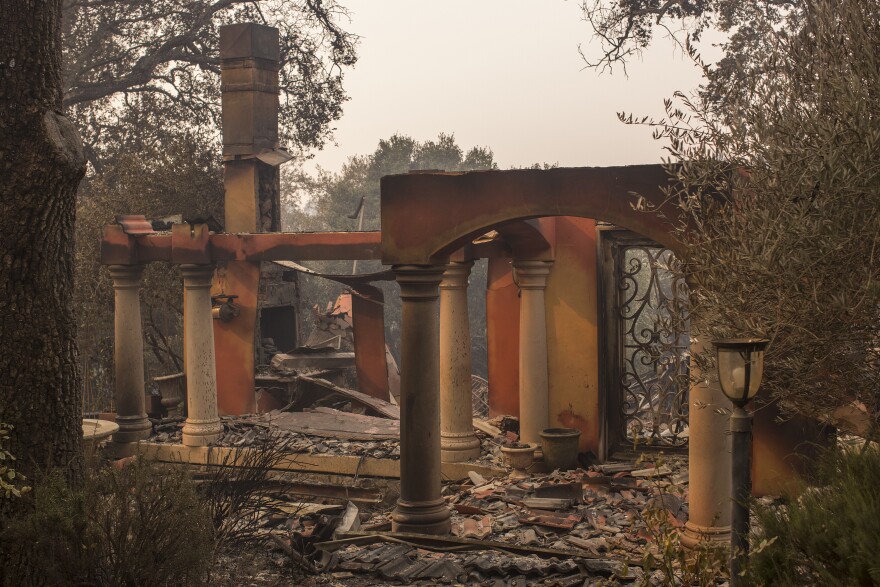People aren't updating beneficiaries in their insurance plan and it's causing a problem, architects come together to help in Napa's rebuild, and ice rink in LA.
Why more SoCal college students are reporting sexual assaults
The UCLA police department just released its 2016 crime report, and the number of reported sexual assaults doubled last year, compared with 2015. This information comes on the heels of similar data from California State University-Northridge, where sexual assaults tripled.
To find out what may account for this disturbing uptick, Take Two's A Martinez spoke with Sheri Strahl. She's chief administrative officer at Strength United, a non-profit advocacy and rape crisis center chartered by CSUN.
Strahl says the higher numbers are due to more survivors coming forward and reporting their assaults. She points to feedback from CSUN's care advocate, a provider who can educate and support a victim without any affiliation with law enforcement.
"Because survivors can go to the campus care advocate, they're learning about the reporting process and it's less scary for them, the barriers are removed," Strahl said. " We're finding as a result that students are reporting more."
Strength United is proud of having helped to create what they believe to be a safer environment for survivors to come forward, but its focus remains on getting at the roots of sexual violence. "We've really been focusing for a long time on risk factors for victimization and putting a lot of the onus and responsibility on survivors," Strahl said. "At CSUN, we've created in the last two years a peer education program called MenCARE. We're really engaging men and people who identify as masculine as allies in preventing sexual violence."
Quotes edited for clarity and brevity.
To hear the full interview, click on the media player above.
Napa Valley vintners recover after October fires
In October, a firestorm devastated Northern California wine country.
"It was quite a shock to wake up early in the morning, probably around 2 a.m., and look out your window and see a ring of fire around the hills," said Kendall Hoxsey-Onysko, a manager with Napa Wine Company.
"Each day it got progressively worse," Hoxsey-Onysko said. "Because all of the power was out, you really didn't even know what was the truth and what was an exaggeration."
The fires are out now. While the remnants of the destruction remain, people in the area agree that conditions are moving in a much better direction.
"Everyone's just taking stock of what areas need attention and what we need to prepare for in the future," Hoxsey-Onysko said. "I see people coming back now to Napa and Sonoma. Perhaps we'll look for the best way to make this place the wonderland that it is."
To hear more about the recovery of Napa Valley wine country, click the blue player above.
How do you fireproof a neighborhood? Architects are helping Napa County rebuild
More than 8,000 buildings were destroyed when wildfires swept through Sonoma and Napa Counties last month. As vineyard owners work with CalFire to rebuild and prevent future fires, Napa County residents are working to replace their lost homes.
Architect Brandon Jorgensen watched as flames burned through Napa. While his home was safe, he knew others weren't so lucky. So, as the orange glow of the fast-moving fire reflected on the ceiling of his home, he texted his friends. "We've got to do something," he wrote, "because if we don't, we're going to make the same mistakes that we made before."
With those friends, Jorgensen created "Architecture of Resilience," a group of architects working on thoughtful design as Napa starts rebuilding burned structures.
What is thoughtful design?
For Jorgensen and his group of architects, thoughtful design is taking all kinds of factors into account, from landscape to the studs in the walls.
It's understanding the landscape, understanding what, if anything, we can do to the landscape. And then, moving from a bigger approach, we would get down into the nitty gritty of the details of the assembly of specific buildings. How can we build a house better so that the studs inside of the wall don't combust? We're trying to start off big and end up with something small and holistic in the end."
Some of the issues they're thinking about...
1. Technology
Technology has been a big point of contention during these NorCal fires. The emergency alert system that was supposed to notify residents failed. So alternatives are being brainstormed.
"Setting up some sort of radio system where each of the houses are spread out, sometimes miles, could communicate with each other. But then using that system, that technology behind that to alert one another or even the computer in the house that a house is down or possibly on fire to register a water suppression system on the exterior of the house."
2. Landscape
"Where the landscape meets the structure -- what that can look like -- could be a very interesting solution to how these fires move so fast, immediately addressing that."
The way to address that? Density. As Jorgensen mentioned, a lot of these homes were miles apart. When looking to rebuild, the Architecture of Resilience group thought to build more densely, which may seem counter intuitive.
"But what we're trying to do is create a break around the structures. So give ourselves at least more than 100 feet of area around these structures that are close together to use the typography to break down the wind, slow down that storm."
3. Materials and shrubbery
A lot of the homes that burned in these fires were surrounded by shrubs and trees, even woodchips. The greenery served as fuel to the fires and increased the likelihood of spontaneous combustion.
By eliminating those factors and considering alternative building materials, such as "concrete or CMU or some other sort of assembly that is fireproof," Jorgensen said, "I think you'll stand a better chance."
To hear more about how resilient architecture and design can be used in Napa County's rebuild, click the blue play button above.
California approves first textbooks under fair representation law
California is the first state in the nation to require that K through 12 students learn about the historical contributions of underrepresented groups, including the LGBT community, the disabled, and religious minorities. These new standards were set forth by the FAIR Education Act passed in 2011.
Last week, the State Board of Education approved the first textbooks to meet this new criteria, but it wasn't without some controversy.
In case you missed it: On Thursday, the @SBECalifornia approved instructional materials that give K-8 students a deeper, broader understanding of history and social science. Read more about it in this news release https://t.co/f3lFv8Kajo pic.twitter.com/RnL5f04Ojn
— CA Department of Education (@CADeptEd) November 13, 2017
For the details on the lengthy approval process, Take Two's Josie Huang spoke with Theresa Harrington. She reports on California Education Policy for EdSource.
The FAIR Education Act of 2011
People from the LGBT community and other ethnic and religious groups felt that their communities were not being fairly and accurately represented. And also, there was a concern about bullying because people in the LGBT community especially go through a lot of bullying in schools…
So they felt that these kinds of non-heterosexual families are portrayed in textbooks, and if we find out that people like Sally Ride, the first woman in space, was a lesbian, suddenly, these kids will see themselves in these textbooks and other kids in their classes will say, hey, wow, I didn’t know there were all these different contributions being made to our society by people who are LGBT.
South Asian representation
There was a large contingent from the Hindu American Foundation, and they were concerned about some of the depictions of Hinduism and Indian culture. Some of the things that were in the textbooks that were rejected had pictures of cows eating trash, which many people said was very offensive to them. They had depictions of Indian people riding elephants and things that they just felt were somewhat disrespectful.
But then at the last minute, other Southeast Asian people were saying that the Hindus were trying to whitewash the caste system. There were people on both sides of that argument.
From publisher to classroom
As it comes into California classrooms, it’s going to be very new for school districts. School districts will go through their own adoption processed, and then teachers will have to be trained in how to have these sorts of discussions with their kids. And so I think a lot of people will be watching California to see how that implementation works out.
Quotes edited for clarity and brevity.
To hear the full interview, click on the media player above.
Have you updated who should get your money once you pass?
You might be due some money, but unless your loved one kept track of his or her paperwork, it might take years to get to you.
California helped hundreds of people claim $11 million last year from their family's life insurance policies by offering a self-service tool promoted by the Department of Insurance.
That money was first lost because before they died, the deceased neglected to update their next of kin or beneficiary.
Why do people lose money?
The insurance company might not track you down to let you know that you've been named as a beneficiary. Sometimes people don’t even know their loved one had a policy, or where it is.
"What happens in many cases is someone will buy a life insurance policy, throw it in a desk drawer or a file cabinet or maybe it will get stuck behind a desk or stuck behind the file cabinet, and everybody forgets about it. The person passes away and no claim is made," said California Insurance Commissioner Dave Jones.
Is there anything you can do to prevent this?
Jones recommends you let someone know about your wishes for what you want to happen to your assets when you die.
"We encourage people to take the time, no matter how few their assets, to prepare a will, to give some direction to whomever is going to be administering your estate as to what your wishes are, and that includes the disposition of assets and also identifying whether you have life insurance policies so that they know to make a claim," he said.
What if I think there’s money out there for me?
There are a number of tools that California’s different departments offer to help link consumers with lost money:
The Ride: International Motorcycle Show rolls into Long Beach this weekend
Friday kicks off the annual International Motorcycle Show in Long Beach, and it features all the usual suspects, with the newest motorcycles, the latest gear and - the industry hopes - more new buyers.
Millennials are the industry's new focus, with stylish bikes that incorporate more technology and versatility and offer them at a lower cost.

Harley-Davidson, which is best known for big touring bikes that appealed to baby boomers, just introduced its new Softail Sport Glide. It's a so-called light touring bike with saddlebags and a windscreen that can be removed without tools.

For 2018, the Honda Gold Wing -- a touring bike with a reputation as the RV of motorcycles -- imports a technology that's been popping up in cars. Apple CarPlay lets riders plug their phones into the infotainment system and use voice commands to operate maps, dictate texts and play music.

Continuing with the car theme, electrics are beginning to come into play. Austrian dirt bike maker KTM is offering an electric model called the Freeride E-XC, which allows an hour of riding per charge.

According to the Motorcycle Industry Council, one in four riders is now female; about 17% of Millennial riders are women -- the largest percentage of any demographic.
An Amazon store inside Whole Foods
Customers used to call Whole Foods "whole paycheck" because of its steep cost. But ever since Amazon acquired the grocery chain, the parent company has aggressively cut prices on basics like turkey and bananas. That move is rattling competitors like Kroger and Sprouts.
In addition, Amazon brought in mini-stores between the aisles of a handful of Whole Foods stores, showcasing speakers and electronic books. Is Amazon transforming the high-end grocery store into a multi-functional shopping center?
Burt Flickinger is managing director of the retail consulting firm Strategic Resource Group. He joined Take Two to talk about what this means for consumers and competitors this holiday season.
Click on the blue media player above to hear more about the new direction of Whole Foods under Amazon ownership.
The 20th anniversary of the Pershing Square holiday ice rink
Southern California is known for its warm winters. That weather usually doesn't lend itself to many traditional holiday activities.
But there's one place in Downtown L.A. that lets people experience some outdoor winter merriment -- the Pershing Square ice rink.
"This rink is actually the biggest in L.A. right now," said Matt Kessinger, with Willie Bietak Productions, a company that's built and installed the ice rink at Pershing Square since 1997.
"Because it's been here so long, it's kind of become the holiday staple for a lot of people," Kessinger said.

There's a lot that goes into putting an ice rink in the middle of Los Angeles. That includes something as simple as making sure that the rink is a flat, smooth surface.
"If you don’t have a level surface, obviously, then water will pool in a certain area so we’ve got to make sure everything is lined up together correctly," Kessinger said. "It’s quite a science."
The ice is real, but a hot day actually doesn't pose as much of a risk of melting the rink as another weather condition does.
"The sun really isn’t as much of a factor as wind. When it’s really windy, the friction of the wind actually causes the ice to melt," Kessinger said.
But his team has plenty of experience dealing with the weather. With thousands of people coming here to skate throughout the season, they plan to use that experience to make sure the 20th anniversary of the ice rink goes as planned.
"It’s quite a big deal especially to be at a landmark location. One location for 20 years like this is pretty awesome," Kessinger said.




